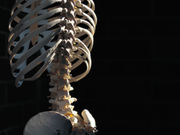After one year, change in bone mineral density was similar in the immediate and deferred groups
FRIDAY, June 30, 2017 (HealthDay News) — Immediate antiretroviral (ART) initiation at HIV diagnosis is associated with greater bone mineral density (BMD) declines compared with deferred initiation, according to a study published online June 26 in the Journal of Bone and Mineral Research.
Jennifer F. Hoy, M.B.B.S., from Monash University and the Alfred Hospital in Melbourne, Australia, and colleagues compared the effect of early ART (CD4 <500 cells/µL) with deferred ART on the change in BMD, measured annually at the lumbar spine and hip using dual energy X-ray absorptiometry (DXA). Baseline and follow-up DXA scans were available for 195 participants in the immediate group and 204 in the deferred group.
The researchers found that, compared with deferred ART, immediate ART correlated with significantly greater BMD declines at the hip (−2.5 versus −1.0 percent; difference, −1.5 percent) and spine (−1.9 versus −0.4 percent; difference, −1.6 percent), through 2.2 years mean follow-up. The greatest declines in BMD were seen in the first year of ART. Spine BMD stabilized in the immediate ART group after one year, while hip BMD declined progressively over two years. BMD changes were similar in the immediate and deferred groups after year one.
“All HIV treatment guidelines now recommend ART initiation at HIV diagnosis because of the reduced risk of serious clinical outcomes,” the authors write. “Better understanding of the longer-term consequences of the observed reductions in BMD is needed.”
Several pharmaceutical companies donated antiretroviral drugs.
Copyright © 2017 HealthDay. All rights reserved.








